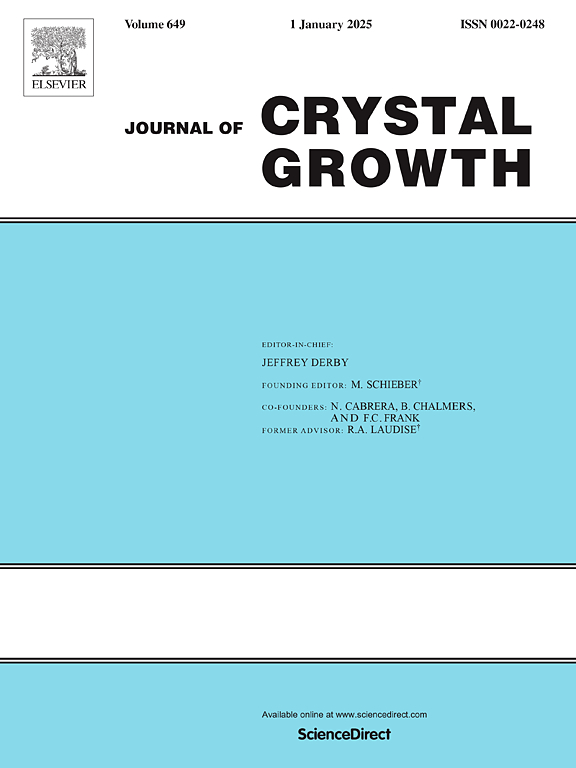氘效应对碳酸镁晶须形貌影响的研究
IF 2
4区 材料科学
Q3 CRYSTALLOGRAPHY
引用次数: 0
摘要
有人提出,正常水中氘含量的几十ppm的扰动可能对水相过程中的某些物理或化学性质产生可测量的影响,这种现象称为“氘效应”。以含40-165 ppm氘的氯化镁和碳酸钠溶液为原料,在30-70℃条件下,采用共沉淀法合成了碳酸镁三水晶须(MgCO3·3H2O),并考察了氘效应对产物形貌的影响。用XRD和SEM对产物进行了表征。用滴定法测定了反应过程中的溶解度。结果表明,氘含量的变化导致晶体形态发生了显著的变化,从以六棱柱为主转变为以四方棱柱为主,夹杂着不规则的六棱柱结构。在相同温度下,氯化镁和碳酸钙在不同氘含量水中的溶解度差异分别高达22.24%和17.91%,说明氘效应对水活度和结晶产物有显著影响。利用形态学和CASTEP模块进行的理论计算表明,氘含量的降低导致MgCO3·3H2O的主要暴露面逐渐从(212)面转变为(301)面,导致晶体从六边形转变为四边形。p轨道控制表面结构的稳定性,氘含量的变化激活(212)平面的态密度,导致形态变化。理论结果与实验结果一致。本文章由计算机程序翻译,如有差异,请以英文原文为准。
Study on the effect of deuterium effect on the morphology of magnesium carbonate whiskers
It is proposed that perturbations of several tens of ppm in the deuterium content of normal water may exert measurable influences on certain physical or chemical properties during aqueous-phase processes, a phenomenon termed the “deuterium effect”. Magnesium carbonate trihydrate whiskers (MgCO3·3H2O) were synthesized by the co-precipitation method using magnesium chloride and sodium carbonate solutions prepared with water containing 40–165 ppm deuterium at 30–70 °C, and the influence of the deuterium effect on product morphology was investigated. The products were characterized using XRD and SEM. The solubility during the reaction process was determined by titration. The results indicate that changes in deuterium content lead to significant variations in crystal morphology, transforming from predominantly hexagonal prisms to mainly tetragonal prisms with inclusions of irregular hexagonal prism structures. At the same temperature, the solubility of magnesium chloride and calcium carbonate in water with different deuterium contents varies by up to 22.24 % and 17.91 %, respectively, demonstrating the significant impact of the deuterium effect on water activity and crystallization products. Theoretical calculations using the Morphology and CASTEP modules revealed that a reduction in deuterium content causes the dominant exposed facet of MgCO3·3H2O to gradually change from the (212) plane to the (301) plane, leading to a transformation of the crystals from hexagonal to tetragonal prisms. The p orbital governs the stability of surface structures, and variations in deuterium content activate the density of states of the (212) plane, resulting in morphological changes. The theoretical results are consistent with the experimental observations.
求助全文
通过发布文献求助,成功后即可免费获取论文全文。
去求助
来源期刊

Journal of Crystal Growth
化学-晶体学
CiteScore
3.60
自引率
11.10%
发文量
373
审稿时长
65 days
期刊介绍:
The journal offers a common reference and publication source for workers engaged in research on the experimental and theoretical aspects of crystal growth and its applications, e.g. in devices. Experimental and theoretical contributions are published in the following fields: theory of nucleation and growth, molecular kinetics and transport phenomena, crystallization in viscous media such as polymers and glasses; crystal growth of metals, minerals, semiconductors, superconductors, magnetics, inorganic, organic and biological substances in bulk or as thin films; molecular beam epitaxy, chemical vapor deposition, growth of III-V and II-VI and other semiconductors; characterization of single crystals by physical and chemical methods; apparatus, instrumentation and techniques for crystal growth, and purification methods; multilayer heterostructures and their characterisation with an emphasis on crystal growth and epitaxial aspects of electronic materials. A special feature of the journal is the periodic inclusion of proceedings of symposia and conferences on relevant aspects of crystal growth.
 求助内容:
求助内容: 应助结果提醒方式:
应助结果提醒方式:


